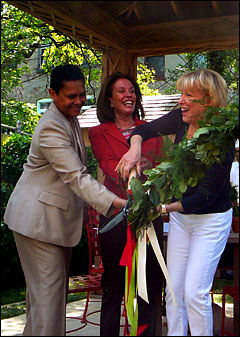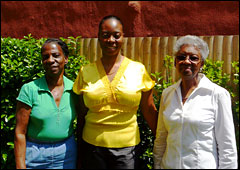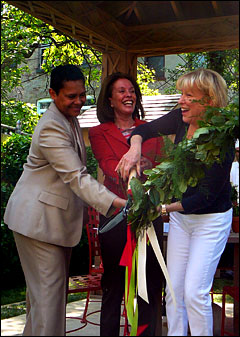Sun, open space, and celebrity — the opening of Brooklyn’s “Garden of Hope” had them all. On an unseasonably warm and sunny afternoon last month, Bette Midler was in high spirits as she celebrated the transformation of a slice of land between two century-old brownstones from a paved walkway with a few trees into a park-like oasis. “I hope anyone who wants to be married will come and be married here,” said Midler with a supernova smile to the neighborhood residents, nonprofit types, local officials, and other invited (and lightly sweating) guests. “I hope that everyone on the block uses this and makes their memories here.”

A garden sprouts in Brooklyn: The Divine Miss Midler (right) with neighborhood resident Marlene Marshalleck (left) and garden designer Ellie Cullman.
Photo: Emily Gertz
In addition to being the Divine Miss M, Midler is a diva of dirt, at least in the five boroughs. In 1995, she founded New York Restoration Project to help revitalize neglected green spaces in low-income city communities. In 1999, NYRP purchased Garden of Hope and dozens of other community gardens on city land from the administration of Mayor Rudy Giuliani, to save them from commercial development.
Like many of the rescued gardens, the Garden of Hope was a hard-luck space carved out of the city’s impermeable surfaces, maintained doggedly and with few resources since the early 1980s by residents in neighborhoods like Bedford-Stuyvesant, a largely African-American enclave in the heart of Brooklyn.
These lots are a legacy of the 1970s, when severely depressed rents led some New York landlords to abandon buildings in low-income neighborhoods — or torch them to collect insurance. The city foreclosed on many such properties after their owners skipped out on their property taxes, but with the economy in a stupor and the city nearly insolvent, the lots went unused, attracting drug dealers and trash. So residents in many neighborhoods took the initiative, cleaning up these lots and transforming them into much-needed community space.
Before the renovation, Garden of Hope was “just a plain area,” says Annie Ruth Williams, treasurer of the local Hancock Neighborhood Block Association, who has lived here since 1964. “There was a paved walkway, a picnic table with benches. Some cedar bushes — someone stole them around Christmas time one year.” But every spring the neighbors turned out to clean up the garden, she said.

Block party: Hancock Block Association members Georgetta Belton, Lori Walters, and Annie Ruth Williams (left to right) bask in their triumph.
Photo: Emily Gertz
Although the area’s gritty history of race riots and street crime has largely given way to a revival of interest in its stately brownstones and quick commute to Manhattan, Bed-Stuy remains home to thousands of low-income residents, many of whom live in public housing projects. And it still has one of the city’s lowest ratios of green space per person. So remaking the Garden of Hope had to take the neighborhood’s real needs into account.
“It’s not a landscape — we designed this as an outdoor room,” says Ellie Cullman. The interior design doyenne is better known for her elite clientele (Oprah is a fan) and her own exquisite Park Avenue apartment than for community gardening. But after being recruited by Midler about two years ago to adopt one of NYRP’s gardens, born-in-Brooklyn Cullman worked with the block association to create a design that met their needs and expectations, and raised nearly all the money needed to do the work.
Cullman and NYRP were “very attentive to our thoughts and ideas,” says Williams of the block association. The designer adapted formal garden traditions to a city neighborhood’s resources and needs, turning the slim, 2,000-foot lot into a progression of circles and squares that lend the space order and calm — while also creating plenty of room for plain old hanging out and running around. Just inside the garden’s gates, a patio offers ample café-style seating. Where the patio ends, a lush green lawn flanked with flowers and shrubs flows back toward the center of the block, studded with groupings of large wooden globes and other features. The lawn is capped with a small, shady wooden gazebo, the likely future venue for memory-making celebrations envisioned by Midler.
Lori Walters, a young woman who has owned a home on the block for five years and is active with the block association, says the garden will become a focal point for the neighborhood, like “a well-maintained living room,” especially for seniors and children.
Annie Ruth Williams agrees. “I’m sure we’ll have more people coming into the garden to read, do needlework, and have tea with your neighbor,” she predicts. “I would.”


